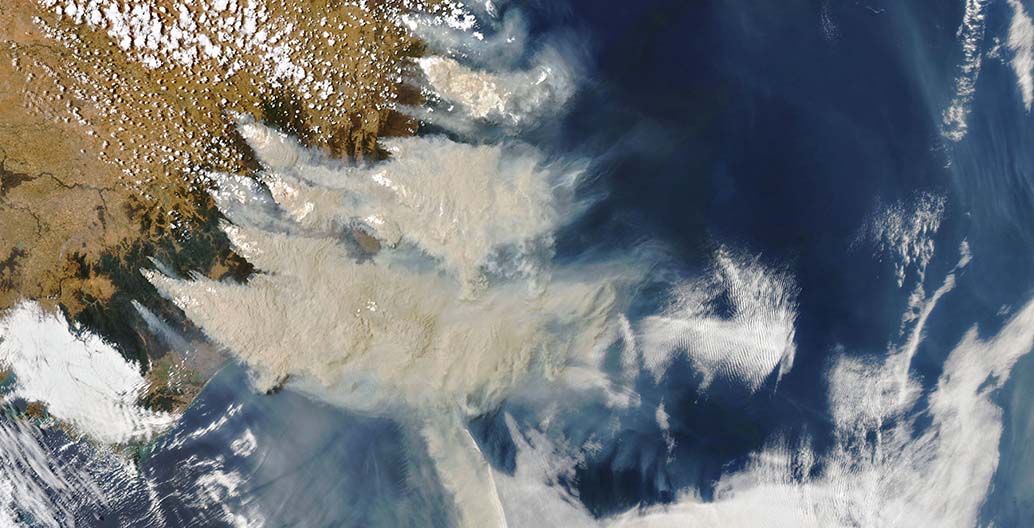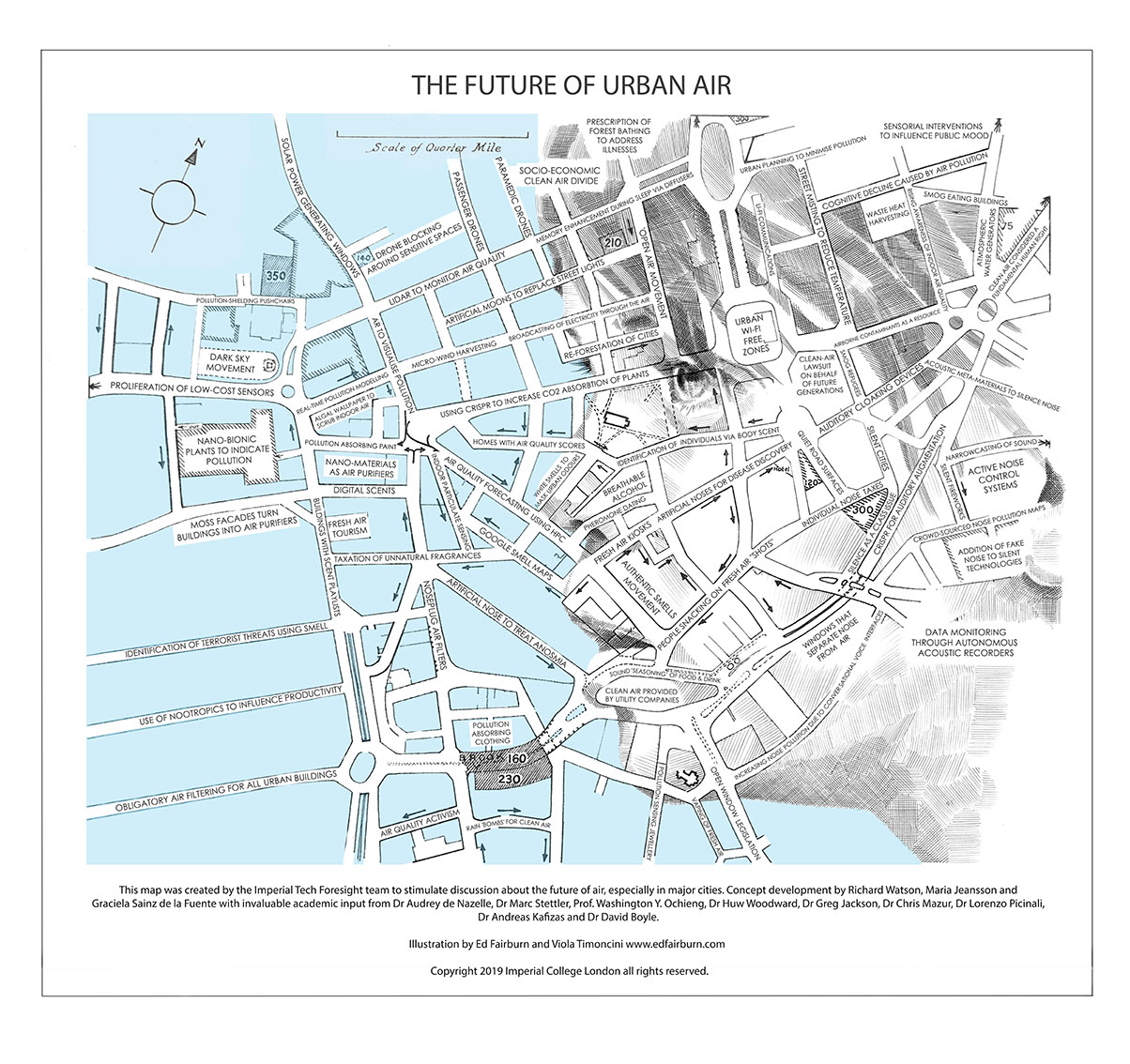
Big smoke: Climate change and the future of urban air
As the nasty airborne effects of climate change choke our cities, we speak with Imperial College London’s Richard Watson about mapping the future of urban air.
As a largely invisible resource, air is often forgotten in the discussion around the way our environments are designed and planned. But with Australia and its neighbours both close and distant steeped in smoke from the country’s on-going bushfire crisis, air quality considerations are suddenly front of mind for millions of people.
Australia’s bushfires notwithstanding, questions around how our cities relate to air, and how that might be changing, have recently been exercising Imperial College London’s Tech Foresight team. Late last year, Tech Foresight’s ‘futurist in residence’ Richard Watson published a ‘street map’ detailing some of the team’s findings in relation to the future of urban air. The infographic is the latest in a series Watson has produced that includes a timeline of emerging science and technology, the future of water, and disruptive technology.
Tech Foresight helps the College’s corporate partners think about the trends and technology that will shape their future business and the organisation has tasked Watson with “extending and disrupting thinking.” As Watson explains, in this respect he finds the technique of mapping is a much more potent tool than, say, a Word document. As a means of visually representing ideas, mapping allows for connections to be drawn more readily between ideas that in the linear form of a list might otherwise seem disparate or unrelated. The maps, too, are also beautiful and engaging in a way that Word documents rarely are (sorry, Clippy).
With many in Australia and around the world beginning to wonder how our cities will cope with the prospect of more and more bushfire particulates, dust storms, pollen plagues and other climate change-induced airborne tribulation, we speak with Watson about what the future might hold for urban air.
(And for those who prefer to digest their ideas as illustrations more so than words, he was kind enough to allow us to reproduce Tech Foresight team’s map, which you can also find below).

Foreground: What prompted you to explore ‘The Future of Urban Air’ in your latest infographic map?
Richard Watson: It was mainly that the World Economic Forum at Davos was getting interested in air (the new water!). There were a couple of Imperial academics going to Davos so it seemed to be the right thing to look air (we’ve already looked into water and food). There’s also an air quality group at Imperial and the mayor of London is quite interested in the subject too, as are most city mayors I imagine. I remember Googling “future of air” too and got no hits, except a few references to a band called Air and something about planes. Next to no Google search results is generally a really good signal!
A key thought was also how to make an invisible vital resource visible. The other other attractive thing about air is that it seems to be largely seen in terms of air pollution, when there is so much more to it than that (noise, smell, light pollution, drones etc).
Foreground: The practice of urban zoning was in part prompted by concerns over air quality – by a desire to ensure residential and commercial areas were kept free from pollution from factories, for example. Is there a renewed interest in improving or controlling air quality at an urban scale? Is this prompting the development of new tools or methodologies in the urban design or planning spheres? Is there a role here for landscape architecture?
Richard Watson: Yes, there’s a new air quality zone that has come into force in London, which I’m sure helps, although I cannot help thinking that zoning is somewhat flawed in that air/pollution does move! The main interest in air quality (which usually means air pollution) stems from China, where the air is clearly (and I use that word deliberately) filthy. But emerging markets have also become interested in indoor air quality, which isn’t really a conversation that’s happening in the West much yet. The central problem, of course, with much of this is that since people can’t see poor air it’s generally ignored. There is obviously a linkage here with things like asthma and we are used to pollen count reading as part of the weather forecast in the summer, but as tech develops we are seeing this slowly change and expand.
We are starting to see smart surfaces and materials that can do anything from harvest resources (solar, wind, water) to remove nasty things like air pollution. e.g. noise reducing paint and concrete that cleans the air. As for using plants and landscaping, trees are the main answer – plant billions of trees (but then you have bushfire risk, although less so in major urban areas). Also gardens more generally – so maybe get people to stop building to the very edge of their plots in urban areas (very urban Australian!) and plant.
Foreground: A number of the features in your infographic map speak directly to concerns about air quality, ie “Obligatory air-filtering for all buildings”, “Air provided by utility companies”, “Homes with air quality scores”. Where have you encountered these technologies, or demand for them?
Richard Watson: The map is essentially speculative, in that is says that these things may come. Having said that, quite a bit already exists, albeit not necessarily in mainstream use.
The demand is certainly there – cyclists in cities wearing masks to reduce pollution (essentially useless), prams with hoods etc to protect against dirty air. There’s even an app that gives real time cleanest air routes to cyclists.
Foreground: Concerns around urban air quality are especially pronounced in Australia at the moment, as smoke from the catastrophic bushfires the country is experiencing blankets its two biggest cities. In your research into urban air, have you come upon any emergent technologies or design developments that might have helped these cities ameliorate the impact of the bushfire smoke?
Richard Watson: No, but I’m sure someone in Australia is now working on it! I’m not sure the solution is tech. Maybe the solution is simply better land management.
Foreground: Your map identifies several trajectories in the future of clean air that have a direct bearing on the exercise of state or governmental power – ‘taxation of unnatural smells’, for example, or ‘clean air as a human right’. Water security is often cited as a key emergent risk for global stability in the 21st century, but with Australia’s bushfire smoke drifting into the skies of distant countries, in South and North America and elsewhere, it is arguably becoming a geopolitical problem. Have you seen any evidence of air or air quality being considered in this way? Does it have any implications from your perspective for international governance and the global response to climate change?
Richard Watson: Well, water is the key resource globally (more so than food, although you can’t really separate the two) but air is even more fundamental. With 70% of people forecast to live in cities by 2050, air quality is really going to get critical. The good/bad news is it’s really an urban problem, so solve it in urban areas and you’ve done a pretty good job generally. But unlike water (or at least more so) air really is a global problem and we already suffer from pollution generated in one country impacting others (think the Indonesian fires impacting Australia). I think air is very much a problem for a body such as the UN.
–
An interactive, zoomable version of Imperial Tech Foresight’s Future of Urban Air map can be found here.


